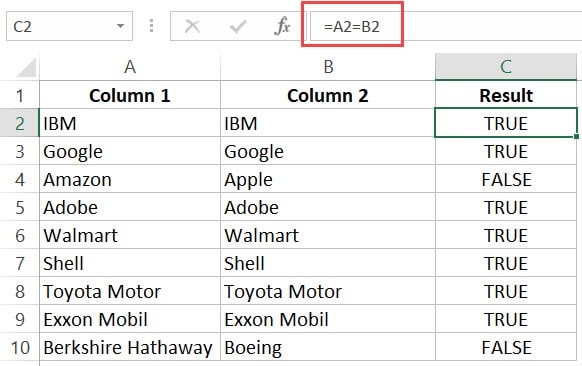Comparing data in Excel is a common task, and highlighting matches between two columns is a quick way to identify similarities. This tutorial provides a comprehensive guide on various techniques to compare two Excel columns and highlight matching data, catering to different scenarios and desired outcomes.
Comparing Columns for Exact Row Matches
The simplest comparison involves a row-by-row check for identical data.
Using a Simple Formula
A straightforward formula can determine if cell contents match within the same row:
=A2=B2This formula returns TRUE if the values in cells A2 and B2 are identical and FALSE if they differ.
Using the IF Formula for Descriptive Results
For more descriptive results, use the IF formula:
=IF(A2=B2,"Match","Mismatch")This displays “Match” for identical cells and “Mismatch” for differing ones. For case-sensitive comparisons, use the EXACT function:
=IF(EXACT(A2,B2),"Match","Mismatch")This differentiates between “IBM” and “ibm,” returning “Mismatch.”
Highlighting Matching Rows with Conditional Formatting
To visually highlight entire rows with matching data:
- Select the dataset.
- Go to Home > Conditional Formatting > New Rule…
- Choose “Use a formula to determine which cells to format.”
- Enter the formula
=$A1=$B1. - Click Format and choose your desired highlighting style.
- Click OK.
Comparing Columns and Highlighting Matches Across Rows
This method highlights matches regardless of their row position.
Highlighting Duplicate Values
To highlight all matching entries across two columns:
- Select the dataset.
- Go to Home > Conditional Formatting > Highlight Cells Rules > Duplicate Values.
- Ensure “Duplicate” is selected and choose your formatting.
- Click OK.
Highlighting Unique Values
To highlight entries present in only one column:
- Select the dataset.
- Go to Home > Conditional Formatting > Highlight Cells Rules > Duplicate Values.
- Select “Unique” and choose your formatting.
- Click OK.
Finding Missing Data Points Using Lookup Formulas
To find data points present in one column but missing in the other, use lookup formulas.
Using VLOOKUP
The VLOOKUP formula checks if a value exists in another column:
=ISERROR(VLOOKUP(A2,$B$2:$B$10,1,0))This returns TRUE if the value in A2 is not found in column B.
Using MATCH
The MATCH function provides a similar functionality:
=NOT(ISNUMBER(MATCH(A2,$B$2:$B$10,0)))This also returns TRUE if the value in A2 is not found in column B.
Conclusion
This guide provides several techniques to compare two columns in Excel and highlight matches, encompassing various scenarios from exact row matches to identifying missing data points. Utilizing these methods allows for efficient data analysis and quick identification of similarities and differences within your datasets. Remember to choose the method that best suits your specific needs and data structure.
